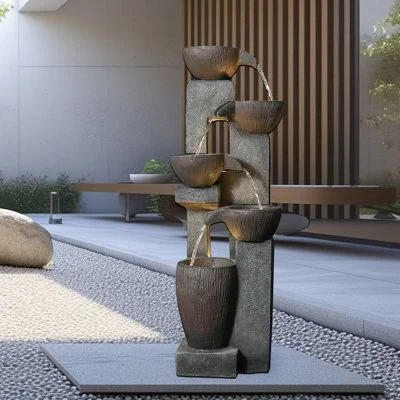Why Are Healthcare Facilities Incorporating Indoor Fountains for Patient Comfort? Improved Calmness and Healing Environment
Creating a calming and soothing environment in healthcare facilities is important for patient recovery. One innovative approach to achieving this is the incorporation of indoor fountains. They improve patient comfort by providing a tranquil and aesthetic atmosphere, which can significantly reduce stress and promote well-being.
Being near water has numerous health benefits, including reducing anxiety and improving mental clarity. Studies show that patients exposed to water features in healthcare settings often experience faster healing and a more positive outlook during their stay. The gentle sound of flowing water from indoor fountains can mask unwanted noises, creating a peaceful environment conducive to rest and recovery.
Moreover, indoor fountains can also improve indoor air quality by adding humidity to the air, which is essential in maintaining a healthy environment. This is particularly beneficial in hospitals where dry air can exacerbate respiratory issues. By incorporating these features, healthcare facilities not only improve the patient experience but also support overall health and comfort.
The Impact of Indoor Fountains on Patient Wellness and Comfort
Incorporating indoor fountains in healthcare facilities can significantly improve patient wellness and comfort by promoting themes of nature and art, addressing patient needs and preferences, and improving indoor environmental quality.
Cultivating a Healing Environment With Nature and Art
Indoor fountains can transform a patient room into a tranquil haven. The presence of nature and art elements like water can reduce stress and anxiety. The sound of flowing water is calming, making it easier for patients to relax. This peaceful background noise can also help mask other disruptive hospital noises, creating a more serene atmosphere.
Visually, fountains add an aesthetic appeal that can lift spirits and provide a soothing focal point. This appeals not only to patients but also to their families, contributing to a better overall patient experience. When patients feel more at peace, their emotional and physical well-being can improve, which can positively influence patient outcomes and comfort.
Understanding Patient Needs and Preferences
Patients' needs and preferences are at the forefront when designing healthcare spaces. Many patients express a desire for environments that feel less clinical and more like home. Indoor fountains can meet these needs by creating a welcoming and serene setting. This shift from sterile to comforting spaces can make a big difference in how patients perceive their stay.
Additionally, the preferences of different patients can vary. Some might benefit more from visual stimuli, like watching water flow, while others might find the sound more beneficial. Having options like fountains allows healthcare facilities to cater to a diverse range of patient preferences, ultimately improving the overall patient experience.
Improving Indoor Environmental Quality
The quality of the indoor environment plays a significant role in patient comfort and well-being. Indoor fountains can contribute to better air quality through evaporation, which adds moisture to the air and can help maintain an optimal humidity level. This is especially important in controlling indoor air quality, which can impact symptoms and overall patient comfort.
In addition to improving air quality, the presence of indoor fountains helps in managing thermal comfort by making the environment feel cooler. Their gentle sounds can mitigate noise pollution from hospital equipment and activities, creating a quieter and more restful space. All these factors combine to provide an environment that supports healing and improves patient outcomes.
Design Considerations and Best Practices for Indoor Fountains in Healthcare Settings
Incorporating indoor fountains in healthcare settings requires careful planning and specific considerations to ensure they benefit patient well-being. Below, we explore various aspects of designing and maintaining these water features to improve patient comfort and facility functionality.
Hospital Design Principles and Layout Optimization
The layout of healthcare facilities must support mobility and accessibility. When placing indoor fountains, ensure they do not obstruct walkways but instead complement the flow of the space.
Optimal placement:
Near waiting areas to calm patients
In therapeutic rooms for sensory improvement
Lobby areas for aesthetic appeal
Thoughtful integration of fountains should improve the overall quality and functionality of the built environment without impacting the performance of healthcare services.
The Relationship Between Patient Comfort and Facility Aesthetics
Patient comfort heavily relies on the aesthetics of the healthcare environment. Indoor fountains add a soothing element through form, color, and sound. They can help reduce stress and anxiety, which are common in hospital settings.
Key Aesthetics:
Form: Smooth, organic shapes
Color: Calming blues and greens
Sound: Gentle water flow
By carefully choosing the fountain’s design, you can significantly improve patient perception and overall comfort.
Incorporating Multisensory Elements for Improved Patient Experience
Indoor fountains offer more than just visual appeal. They can be part of a multisensory approach to patient therapy.
Multisensory Elements:
Visual: Pleasing to the eyes
Sound: Calming water sounds
Touch: Potential for tactile interaction
Combining these elements can create a holistic therapeutic environment, promoting a positive mental and emotional state among patients.
Safety, Sustainability, and Infection Control
Safety is important in healthcare facilities. Ensure that the fountains are made of non-slip materials to prevent accidents. Sustainability should also guide material selection and water usage.
Key Considerations:
Materials: Eco-friendly and durable
Water Management: Efficient use and recycling
Infection Control: Regular cleaning and maintenance
Plastics and other materials that are easy to disinfect should be used to prevent contamination and ensure a hygienic environment, supporting the overall quality care standards.
Each of these elements plays a key role in integrating indoor fountains effectively within healthcare settings, improving both function and patient experience.
Incorporating indoor fountains in healthcare facilities offers numerous benefits. These features create soothing environments that promote patient healing and comfort. By reducing stress, improving air quality, and improving visual aesthetics, indoor fountains contribute significantly to patient well-being.
Adopting these design elements reflects a commitment to holistic patient care. It shows that healthcare facilities value both physical and mental health, encouraging a supportive atmosphere for everyone.




